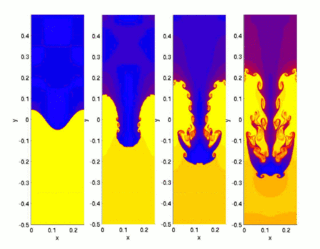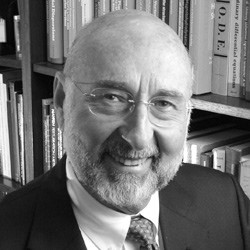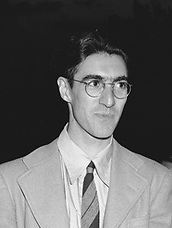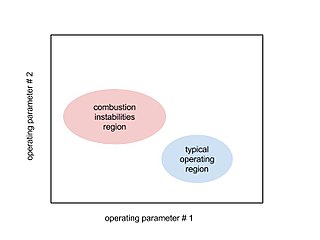Related Research Articles

In plasma physics, plasma stability concerns the stability properties of a plasma in equilibrium and its behavior under small perturbations. The stability of the system determines if the perturbations will grow, oscillate, or be damped out. It is an important consideration in topics such as nuclear fusion and astrophysical plasma.

In dynamical systems instability means that some of the outputs or internal states increase with time, without bounds. Not all systems that are not stable are unstable; systems can also be marginally stable or exhibit limit cycle behavior.

Electrohydrodynamics (EHD), also known as electro-fluid-dynamics (EFD) or electrokinetics, is the study of the dynamics of electrically charged fluids. It is the study of the motions of ionized particles or molecules and their interactions with electric fields and the surrounding fluid. The term may be considered to be synonymous with the rather elaborate electrostrictive hydrodynamics. ESHD covers the following types of particle and fluid transport mechanisms: electrophoresis, electrokinesis, dielectrophoresis, electro-osmosis, and electrorotation. In general, the phenomena relate to the direct conversion of electrical energy into kinetic energy, and vice versa.

The Rayleigh–Taylor instability, or RT instability, is an instability of an interface between two fluids of different densities which occurs when the lighter fluid is pushing the heavier fluid. Examples include the behavior of water suspended above oil in the gravity of Earth, mushroom clouds like those from volcanic eruptions and atmospheric nuclear explosions, supernova explosions in which expanding core gas is accelerated into denser shell gas, instabilities in plasma fusion reactors and inertial confinement fusion.

In fluid dynamics, the Taylor–Couette flow consists of a viscous fluid confined in the gap between two rotating cylinders. For low angular velocities, measured by the Reynolds number Re, the flow is steady and purely azimuthal. This basic state is known as circular Couette flow, after Maurice Marie Alfred Couette, who used this experimental device as a means to measure viscosity. Sir Geoffrey Ingram Taylor investigated the stability of Couette flow in a ground-breaking paper. Taylor's paper became a cornerstone in the development of hydrodynamic stability theory and demonstrated that the no-slip condition, which was in dispute by the scientific community at the time, was the correct boundary condition for viscous flows at a solid boundary.
Dynamic instability may refer to any of several scientific phenomena:
The Orr–Sommerfeld equation, in fluid dynamics, is an eigenvalue equation describing the linear two-dimensional modes of disturbance to a viscous parallel flow. The solution to the Navier–Stokes equations for a parallel, laminar flow can become unstable if certain conditions on the flow are satisfied, and the Orr–Sommerfeld equation determines precisely what the conditions for hydrodynamic stability are.
Viktor Vasilyevich Dilman, also spelled Dil'man is a Russian scientist performing research for USPolyResearch. He is best known for his work in chemical engineering and hydrodynamics including the approximate methods for solving nonlinear differential equations of mass, heat, and momentum transfer; mathematical modeling of chemical reactor processes and catalytic distillation; heat, mass, and momentum transfer in turbulent flow; fluid dynamics in granular beds; surface convection, absorption, and molecular convection.

In fluid dynamics, hydrodynamic stability is the field which analyses the stability and the onset of instability of fluid flows. The study of hydrodynamic stability aims to find out if a given flow is stable or unstable, and if so, how these instabilities will cause the development of turbulence. The foundations of hydrodynamic stability, both theoretical and experimental, were laid most notably by Helmholtz, Kelvin, Rayleigh and Reynolds during the nineteenth century. These foundations have given many useful tools to study hydrodynamic stability. These include Reynolds number, the Euler equations, and the Navier–Stokes equations. When studying flow stability it is useful to understand more simplistic systems, e.g. incompressible and inviscid fluids which can then be developed further onto more complex flows. Since the 1980s, more computational methods are being used to model and analyse the more complex flows.

Stephen Howard Davis was an American applied mathematician working in the fields of fluid mechanics and materials science. Davis was the McCormick School Institute Professor and the Walter P. Murphy Professor of Applied Mathematics at Northwestern University. Davis has been listed as an ISI Highly Cited researcher in Engineering. His work was acknowledged in festschrifts in 2002.

Robert Davis Richtmyer was an American physicist, mathematician, educator, author, and musician.

Alexey Maksimovich Fridman was a Soviet physicist specializing in astrophysics, physics of gravitating systems and plasma physics. He discovered new types of instabilities in gravitating media, created the theory of planetary rings and predicted the existence of small Uranus satellites that were later discovered. He also developed the hydrodynamic theory of spiral structure in galaxies. Fridman worked at the Institute of Astronomy of the Russian Academy of Sciences, INASAN, and was professor at the Moscow Institute of Physics and Technology and at Moscow State University.
Anadi Sankar Gupta was an Indian mathematician. Till his death, he was an INSA Senior Scientist and emeritus faculty with the Department of Mathematics, IIT Kharagpur.
The Darrieus–Landau instability or hydrodynamic instability is an instrinsic flame instability that occurs in premixed flames, caused by the density variation due to the thermal expansion of the gas produced by the combustion process. In simple terms, the stability inquires whether a steadily propagating plane sheet with a discontinuous jump in density is stable or not. It was predicted independently by Georges Jean Marie Darrieus and Lev Landau. Yakov Zeldovich notes that Lev Landau generously suggested this problem to him to investigate and Zeldovich however made error in calculations which led Landau himself to complete the work.
Philip Gerald Drazin was a British mathematician and a leading international expert in fluid dynamics.
Patrick Huerre, born in 1947, is a French physicist in fluid mechanics. An engineer from the École centrale de Paris (1970), and a doctor of aeronautical sciences from Stanford University, he began his career at the University of Southern California in Los Angeles. In 1989, he was appointed Professor of Mechanics at the École polytechnique where he created, with Jean-Marc Chomaz, and then directed the Laboratoire d'hydrodynamique (LadHyX), a joint CNRS-École polytechnique research unit. He is currently Director of Research Emeritus at the Centre national de la recherche scientifique (CNRS). He is a member of the French Academy of Sciences.

Combustion instabilities are physical phenomena occurring in a reacting flow in which some perturbations, even very small ones, grow and then become large enough to alter the features of the flow in some particular way.
Nader Masmoudi is a Tunisian mathematician.
Diffusive–thermal instability or thermo–diffusive instability is an intrinsic flame instability that occurs both in premixed flames and in diffusion flames and arises because of the difference in the diffusion coefficient values for the fuel and heat transport, characterized by non-unity values of Lewis numbers. The instability mechanism that arises here is the same as in Turing instability explaining chemical morphogenesis, although the mechanism was first discovered in the context of combustion by Yakov Zeldovich in 1944 to explain the cellular structures appearing in lean hydrogen flames. Quantitative stability theory for premixed flames were developed by Gregory Sivashinsky (1977), Guy Joulin and Paul Clavin (1979) and for diffusion flames by Jong S. Kim and Forman A. Williams (1996,1997).
References
- Chandrashekhar, S., Hydrodynamic and Hydromagnetic Stability, Dover Publications, New York (1981).
- Drazin, P. G. and W. H. Reid, Hydrodynamic Stability, Cambridge Univ. Press, London (1981).